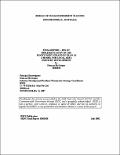| Abstract | The Rocky Point Strategic Plan was initiated as a direct result of concern from both growers and the sugar mill about the future viability of the local industry. The aim was to follow a similar procedure to the Maryborough cane industry with the vision of duplicating their success story.At the same time as the Strategic Plan was evolving the Gold Coast City Council (GCCC) was developing a Reclaimed Water Scheme (part of the Northern Wastewater Strategy) involving the use of this water for irrigation of cane at Rocky Point.In January 2000 I was employed by the BSES as a Development Officer and Northern Wastewater Reuse Coordinator under a jointly funded 3 year project by SRDC and GCCC to assist with the Strategic Plan and provide liaison between the GCCC and the cane industry.A work plan was produced with specific goals and activities. Priority was allocated to work activities that were expected to have the greatest impact on achieving the goal of reaching the annual cane production of 550,000 tonnes. High Density Planting (HDP), Irrigation and Lateral Expansion were seen as the major drivers for achieving this goal.A change in row spacing from single to quad rows (HDP) has been identified in local trials as the best opportunity for growers to lift productivity. For example, quad row Q138 plant cane yield at the Skopp site was 140 tc/ha compared to 90 tc/ha for the conventional single rows. It is also worth noting that there was a positive response in favour of the quad rows with all HDP trials at Rocky Point, with all varieties (Q138, Q141, Q124). However because of the cloud over the future of quad rows, the short-term solution to increasing production by changing row spacing appears to be with convincing growers to adopt the dual row system, and trial work was initiated to promote this change. The impact of this on production predictions is enormous. Quad rows were expected to provide a 40% increase in productivity compared to 15% for dual rows.Lateral expansion through growing cane at Beaudesert was identified as a potential source of increased cane supply. A nursery of cane plants has been established at Beaudesert and was expected to grow to 30,000 by 2003. However the current low cane price has produced a negative impact on this initiative. Unless there is a positive upward movement in the cane price in the near future, the cane production from the Beaudesert area will remain insignificant (<3,000 t).Irrigation of cane using water from the GCCC Reclaimed Water Scheme is expected to commence in August 2004. There was an excellent response from growers to the expressions of interest for allocation of reclaimed water for irrigation of cane. The area of irrigation from Stage 1A of the scheme will be 340 ha and involve six farmers. In general, cane farmers at Rocky Point have limited experience with irrigation. An effort was made to educate Rocky Point cane farmers on irrigation with the aim of establishing a good knowledge of Best Practice Irrigation before the commencement of irrigation in the district using reclaimed water. Also, the surface irrigation trial conducted this season has provided valuable information on crop response to irrigation and irrigation scheduling.Other activities to encourage growers to increase production were based on general extension of the Best Management Practice principles endorsed by the BSES. Improved weed control management would top the list of activities that was expected to have the most impact. |

